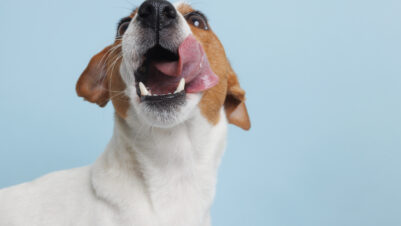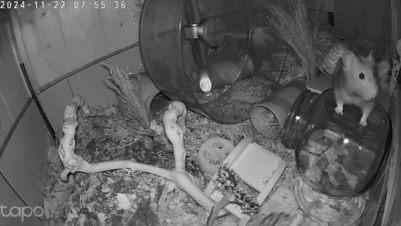
A dog behavioural problem may have an underlying clinical cause, which the vet can diagnose or eliminate prior to a dog behaviour consultation. This is particularly the case with sudden fearfulness, aggression, anxiety or something out of character, or if anything different is noticed. For some individual dogs exhibiting behavioural problems, a vet may decide to prescribe psychotherapeutic agents to ease the implementation of a behaviour modification plan (White, 2024).
Factors influencing dog behaviour
Visits to the vet can feel easier for dogs that have had positive handling, experiences and choices; however, naturally not all dogs feel comfortable at the vet. There are still variables that affect fear at the clinic, with up to half of the dogs visiting a vet clinic experiencing a level of fear (Edwards et al., 2019).
Up to half of the dogs visiting a vet clinic experiencing a level of fear
Behaviour exhibited by a dog visiting the vet may be due to contextual factors or other behavioural history. According to the study by Edwards et al. (2019), which investigated risk factors that predict fear, only 7 percent of chosen parameters (breed, activities the dog was involved in, weight, where purchased, owner experience and age of other household dogs) predicted variation of fear at the clinic. The study also acknowledged that other influences and variables, which were not included in the study, can affect behaviour at the clinic. These include the environment, clinic set-up, previous vet visits and dog–human interaction. It is also useful to acknowledge that the dog’s history and background may affect exhibited behaviour, especially a dog with existing behavioural problems.
Dog behaviour in clinic
Veterinary staff are aware that required vet visits are often stressful for some dogs. Visits can involve stress, fear and aggression, and exhibition of behaviour issues, especially when considering the dog’s medical status. A dog that has had several necessary but perhaps painful procedures may feel apprehensive and a trigger stimuli for that dog may be present in the environment. The dog may then be fearful, aggressive towards dogs or people, or have handling issues, for example.
Staff may make dog behavioural observations at the veterinary practice which can then feed into a behavioural plan set up by the behaviourist. Observations without judgement can support the plan, including interactions between dog and staff; interactions between dog and owner; what made the dog more at ease; what made them unsettled in a specific context; and the dog’s response. This helps add to the behavioural history, which along with many other factors can provide a detailed history for the behaviourist to look at, to feed into behaviour modification.
After the vet’s medical assessment and their professional service, it is time to then refer to a behaviourist for behavioural evaluation and recommendations. The owner is not alone in experiencing dog behavioural problems and its effect on life. Behaviour problems can feel stressful for the dog and owners and can strain their valued dog–owner bond.
Dog–owner bond and behaviour
Dogs live closely with us sharing many activities. Owning a dog is rewarding, whether it is for companionship or as a working partner. What if this relationship is crumbling? Indeed, in some cases the dog–owner relationship has deteriorated due to behavioural problems. The owner wants to get the relationship and behavioural problem back on track.
However, the dog’s experience of the dog–owner relationship and past relationships, the attachment style of the dog and the caregiver’s manner, management and communication style are all variable factors. Any imbalance or misunderstanding in these factors in the relationship may highlight sources of relationship dysfunction.
Knowing that this is useful can help guide and adjust the relationship to become less stressful and more mutually cooperative for dog and owner. A dysfunctional dog–owner relationship does not indicate a bad owner, or dog, but just a relationship that needs guidance.
With an animal behaviourist’s help, the owners can enhance their dog–owner relationship for the better and learn how to influence behaviour (Rehn and Keeling, 2016). Repairing or enhancing the dog–owner bond is an important aspect in resolving dog behaviour problems. Understanding their pet better enhances the relationship, promotes cooperation and increases the potential to resolve the behavioural concern.
Owner management of behavioural problems
Assessment of the current and past owner behavioural management methods is part of the behaviour assessment. Commonly, methods used so far by the owner have not resolved the behaviour. The owner may state that, frustratingly, their dog repeats the behaviour, or that it is getting more frequent or intense.
Rather than use the vet or behaviourist route to address behavioural problems, some owners increasingly seek non-professional, random sources of social media, YouTube and TV for solutions. These suggestions can use punitive and aversive methods, affecting welfare, that are not the solution and will compound the problem. The Blue Cross is concerned that such owners do more harm than good by using these sources to try to change unwanted behaviour. Methods from such sources may also be incongruous, misconstrued, incomplete and not science-led or tailored to the dog (Blue Cross, 2022).
More subtle signs and development indications of behavioural problems are often missed by owners. Perhaps at the point of seeking help for the dog, the exhibited behaviour has become more significant and stressful. The current management plan may not be right for the dog and needs a new approach, methodology and understanding. A tailored comprehensive behaviour modification plan will be designed by a behaviourist.
It was found that the owner’s relationship with their dog and their personality, behaviour, communication style, training methods or interactions had a statistically significant association with the development of various behavioural concerns
Guiding owners to understand and help their dog is important. In a study by Jagoe and Serpell (1996), it was found that the owner’s relationship with their dog and their personality, behaviour, communication style, training methods or interactions had a statistically significant association with the development of various behavioural concerns. Many great owners just need guidance where they are not judged; rather, they need to be helped with new techniques and this can enhance their relationship with their dog (Jagoe and Serpell, 1996).
The importance of understanding the dog
Dogs are socially cooperative species that through domestication have become encultured with humans. To a dog, the cohesion of a social network of relationships, maintained by vocalisations and body language to avoid overt aggression, is very important. Equilibrium is sought to facilitate a homeostatic environment for the propensity to seek cooperation, enabling optimal fitness of the individual and of the group.
A dog’s social system can be seen as autopoietic, which means that the social system is self-regulating. It is in a constant state of flux aiming to attain optimal individual and group homeostasis. Maintaining homeostasis of an individual dog affects and is affected by the dynamic within the group. The social system of dogs is a flexible balance of varying dynamics in their individual relationships with many individual conspecifics. It is a network of binary relationships, and within the network interactions may be brief or continuous while constantly balancing variables. Each dog’s behaviour will affect another in a reciprocal learning process. A dog’s exhibited behaviour is a result of, or in response to, that of a conspecific, or instigated as a response to that conspecific (Semyonova, 2003).
Owners need to be guided to understand the dog’s communication and body language, and to read and explain the dog’s behaviour
Therefore, dominion and not domination with the socially cooperative dog is the key to addressing dog behaviour problems. Owners need to be guided to understand the dog’s communication and body language, and to read and explain the dog’s behaviour. In doing so, owners build trust and mutual respect with their dog so the dog can learn, along with safety suggestions, management, behavioural modification and training (bespoke to that dog). We can then begin to influence the dog to choose a different behaviour.
Outcome of vet and behaviourist teamwork
To conclude, there is a two-step process whereby the vet notes down relevant behaviours and discussions with the client using their veterinary expertise. They then refer to a suitably qualified behaviourist via the APBC or ABTC, who then uses their expertise in dog behaviour to help the owners. Teamwork between the two professions is vital for the best outcome for dog and owner.






